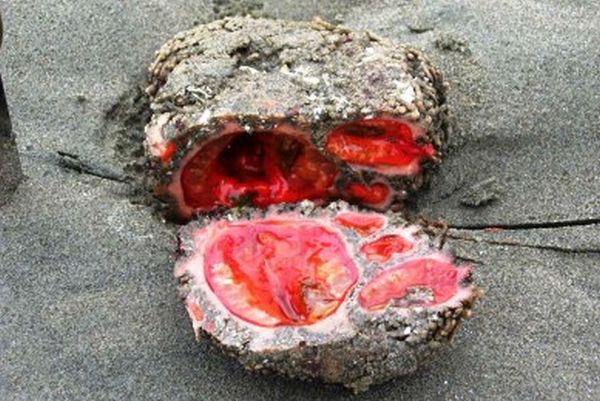Pyura chilensis
Notwithstanding appearances, this is not some sort of remorselessly cut up outsider stone living being or a tomato thunderegg. This is Pyura chilensis, an ocean animal that lives on the rough shore of Chile and Peru. Furthermore, if (like me, as of late) you've never observed one of these, you'll most likely be intrigued to realize that in Chile, they are angled industrially, and local people eat them crude or cooked with plate of mixed greens and rice in light of the fact that obviously they're tasty.
P. chilensis has a place with the Ascidiacea class of non-moving, sac-like marine invertebrate channel feeders that are also called ocean squirts. They have a place with the Tunicata subphylum, alleged in light of the fact that they wear thick "tunics" made of tunicin, which is a solid grid of particles that help the creature append itself to a hard surface on which it will complete its days. The internal parts of this tunic are fixed with an epidermis and a strong band, and inside these layers lies the fundamental part of the creature.
Read aslo: Sydney, Australia
P. chilensis has two siphons that associate the creature to the encompassing sea through its tunicin – one for breathing out and one for breathing in. It eats by breathing in the water and sifting through the palatable microalgae utilizing a moving layer of bodily fluid in its extended pharynx, or branchial sac, before breathing out the water pull out the other siphon. The pharynx is associated with the creature's digestive tract, which fundamentally acts like a mouth.
Their blood is clear and, oddly, can accumulte to a great degree high characteristics of a baffling and uncommon component called vanadium. The convergence of vanadium in the blood of P. chilensis and different tunicates can be up to 10 million times that of the encompassing seawater. Exactly why and how these animals can collect vanadium in such immense amounts stays obscure.
P. chilensis can regularly be found in thickly stuffed totals of thousands or little modest bunches of only a couple, or they can be found all alone - in which case they should replicate all alone, as there is no chance to get of them moving to discover a mate. This implies P. chilensis is androgynous, with the gonads of both a male and a female that can discharge eggs and sperm simulataneouly to meet as a rich cloud in the encompassing water. In the event that the sperm-egg crashes are effective, they will create minor tadpole-like posterity that will in the long run settle onto a stone to develop into the grown-up shape.


Comments
Post a Comment